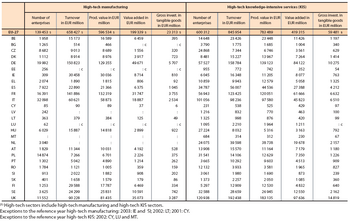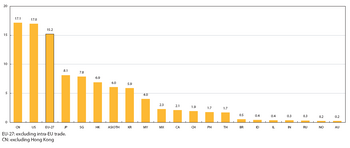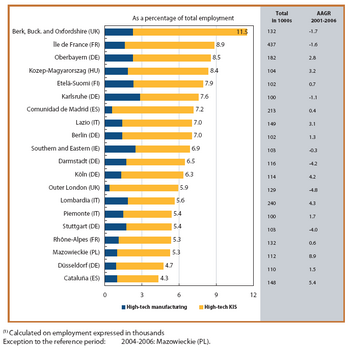Archive:High-tech statistics
(Data from August 2008)
Creating, exploiting and commercialising new technologies has become essential in the global race for competitiveness. High-technology sectors are key drivers of economic growth, productivity and welfare, and are generally a source of high value added and well-paid employment. Technology-intensive enterprises are often referred to as high-technology – or high-tech – companies.
But what exactly is high-tech? Eurostat collects all available high-tech statistics under the more formal name Statistics on high-tech industry and knowledge-intensive services and defines high-tech according three approaches; the sector approach, the product approach and the patent approach. The sector approach looks at for example; high-tech manufacturing sector, medium high-tech manufacturing sector, high-tech knowledge-intensive service (KIS) sector, and more, and focuses on employment, earnings and economic indicators. The product approach looks simply at whether a product is a 'high-tech product' or not and examines trade with high-tech products. The patent approach similarly looks at whether a patent is a 'high-tech patent' or not.
Main statistical findings
Text with Footnote [1]
Economic statistics on high-tech sectors
In 2004, the EU-27 counted almost 140 000 enterprises in high-tech manufacturing and four times as many in high-tech knowledge intensive services (600 000). High-tech manufacturers were most numerous in Italy, Germany, France and Poland, accounting together for around two-thirds of the high-tech sector in the EU-27. The United Kingdom counted the most enterprises in the high-tech KIS sector (120 938), comprising almost one fifth of the EU-27 total, followed by Italy, Germany and France.
A different picture emerges when considering turnover; Germany led the way in 2004, with a total turnover of EUR 150 billion in high-tech manufacturing, ahead of France (EUR 141 billion) which ranked first in the previous year. The United Kingdom ranked third (EUR 90 billion), although its turnover has gone down from 2003. One of the main reasons for this is the size of the high-tech manufacturing sector in the UK, which was smaller than its main EU counterparts. This is particularly relevant when compared to Italy, which counted almost three times as many enterprises in high-tech manufacturing than the UK.
Considering the high-tech KIS sector, it is striking that turnover; production value and value added were almost twice as high in the United Kingdom than in Italy. Germany was well ahead in terms of value added generated by high-tech manufacturing, with almost EUR 50 billion, while the UK was ahead in KIS with just under EUR 100 billion.
The average labour productivity in the EU 27 in high tech sectors was EUR 69 000. However, labour productivity in individual Member States varied considerably in relation to this average. As in the previous year Ireland remained in first position with an average labour productivity of EUR 145 000, followed by Luxembourg with EUR 115 000. Among the new Member States, only Cyprus was above the EU-27 average, with EUR 75 000, while labour productivity in Portugal, Italy and Greece hovered just below the EU average.
Trade in high-tech products
In 2006, aside from the world's four leading economies, where the EU is counted as one single economy, only ten other countries (entities) recorded shares of more than 1% of global exports in high-tech products. The four leaders at world level were China (17.1%), the United States (17.0%), the EU-27 (15.2%) and Japan (8.1%). Among all the countries, Singapore, Hong Kong, “other Asian countries” and South Korea each accounted for more than 5% of high-tech exports. Behind this group of countries came Malaysia, with 4%, and a group comprising Mexico, Canada, Switzerland, the Philippines and Thailand, with shares of around 2% of global exports. Brazil, Indonesia, Israel, India, the Russian Federation, Norway and Australia registered global export shares in high-tech products ranging between 0.5% and 0.2%.
In 2006, the 21 largest exporting countries (entities) accounted for 99% of global exports in high-tech products.
Employment in high-tech
In 2006, 39 million people were employed in the manufacturing sector in the EU-27, which equates to 18.2% of total EU employment. With more than 8 million, Germany counted the most people employed in manufacturing, followed by Italy and the United Kingdom. Of these 39 million workers, almost 12 million were employed in medium-high-tech manufacturing and only 2.3 million in high-tech manufacturing.
In the EU-27, women accounted for 30.8% of employment in manufacturing. Across all EU Member States, the share of women employed in the manufacturing sector was below 50%, although gender parity was almost achieved in Bulgaria and Romania (49.6% and 48.0% respectively); as a rule, this ratio was often higher in the new Member States. In medium-high-tech manufacturing, the share of female employment was lower than in high-tech manufacturing (23.8% and 34.8% respectively), and women in the latter sector outnumbered their male counterparts in Bulgaria, Hungary and Slovakia.
European employment in total manufacturing slightly increased between 2001 and 2006. This was also true for the medium-high-tech manufacturing sector. However, the number of jobs in high-tech manufacturing decreased on average by 1.7% a year during the same period. At Member State level, employment in this sector grew in nine Member States, with the largest increases registered in Slovakia and Poland. In general, the countries where the high-tech manufacturing employment increased are the countries that have recently joined the EU. This was also the case for Spain and Turkey. Conversely, in Sweden and the Netherlands employment in high-tech manufacturing was down by more than 10% between 2001 and 2006.
High-tech employment at regional level
Figure 2 presents the top 20 regions in terms of employment in high-tech sectors in 2006, as a share of total employment and the annual average growth rate from 2001 to 2006. In 2006, the leading region was Berkshire, Buckinghamshire and Oxfordshire (UK), with high-tech sectors accounting for 11.5% of total employment. This was followed by Île de France (FR), with 8.9% and Oberbayern (DE), with 8.5%.
Out of the 20 leading regions, seven were found in Germany, three in Italy, two in France, the UK and Spain, and one in Ireland, Finland, Hungary and Poland, the two latter being the only representatives from the New Member States.
In terms of annual average growth rate, employment in high-tech sectors as a share of total employment increased in 13 of the 20 leading regions. Mazowieckie (PL) showed the highest growth rate (8.9%), followed by Cataluña (ES), with an increase of 5.4% on average per year. In contrast, over the same period the share of employment in high-tech sectors fell in Outer London (UK), Darmstadt (DE) and Stuttgart (DE) by an annual average of 4.8%, 4.2%, and 4.0% respectively. Employment in high-tech sectors also decreased in Berkshire, Buckinghamshire and Oxfordshire (UK), Île de France (FR), Karlsruhe (DE) and Southern and Eastern (IE). Most of the population employed on high-tech was devoted to high-tech knowledge-intensive services (high-tech KIS). Karlsruhe, in Germany, and Southern and Eastern, in Ireland, show the highest percentages of employment in high-tech manufacturing, while Outer London (UK) and Comunidad de Madrid (ES) stay at the other end of these top 20 regions.
Considering the difference between the shares of people employed in high-tech manufacturing and the share of people employed in high-tech KIS, the largest discrepancies were found in Berkshire, Buckinghamshire and Oxfordshire (UK), Île de France (FR), Comunidad de Madrid (ES) and Outer London (UK).
Data sources and availability
<description of data sources, survey and data availability (completeness, recency) and limitations> High-tech statistics uses various other domains and sources mainly within Eurostat's official statistics (CIS, COMEXT, HRST, LFS, SBS, SES, PAT and R&D). Its coverage and availability is therefore dependent on these other primary sources.
The sectoral approach is an aggregation of the manufacturing industries according to technological intensity (R&D expenditure/value added) and based on the Statistical Classification of Economic Activities in the European Community (NACE) at 2 or 3-digit level for compiling aggregates related to high-technology, medium high-technology, medium low-technology and low-technology. Services are mainly aggregated into knowledge-intensive services (KIS) and less knowledge-intensive services (LKIS) and defined according to a similar logic at NACE 2-digit level.
Note that due to the revision of the NACE from NACE Rev. 1.1 to NACE Rev. 2 the definition of high-technology industries and knowledge-intensive services has changed. For high-tech statistics it means that two different definitions (one according NACE Rev. 1.1 and one according NACE Rev. 2) will be used in paralell as long as necessary. The data in this article is by NACE Rev. 1.1.
The product approach was devised to complement the sectoral approach. The product list is based on the calculations of R&D intensity by groups of products (R&D expenditure/total sales). The groups classified as high-technology products are aggregated on the basis of the Standard International Trade Classification (SITC). The product approach is used for data on high-tech trade.
Due to the revision of the SITC from SITC Rev. 3 to SITC Rev. 4 the definition of high-tech products has changed as well. High-tech statistics will start publishing statistics based on SITC Rev. 4 sometime in 2009. The data in this article is by SITC Rev. 3.
High-tech patents are defined according to another approach. The groups classified as high-tech patents are aggregated on the basis of the International Patent Classification (IPC 8th edition). Biotechnology patents are also aggregated on the basis of the IPC 8th edition.
Context
EP/Council Decision No 1608/2003 concerning the production and development of Community statistics on science and technology and Commission Regulation No 753/2004 as regards statistics on science and technology determine the production and development of statistics on high-tech (in particular with regard to activities, products, contribution to the whole economy, etc.).
Further Eurostat information
Publications
- Title of the publication
- Title of the publication
- Title of the publication
- Title of the publication
- Title of the publication
- Title of the publication
- Title of the publication
- Title of the publication
- Title of the publication
- Title of the publication
Main tables
- Title(s) of second level folder (if any)
- Title(s) of third level folder (if any)
Database
- Title(s) of second level folder (if any)
- Title(s) of third level folder (if any)
Dedicated section
Other information
<Regulations and other legal texts, communications from the Commission, administrative notes, Policy documents, …>
For other documents such as Commission Proposals or Reports, see EUR-Lex search by natural number
External links
See also
[[Category:<Category name(s)>]]
Notes
- ↑ Text of the footnote.



